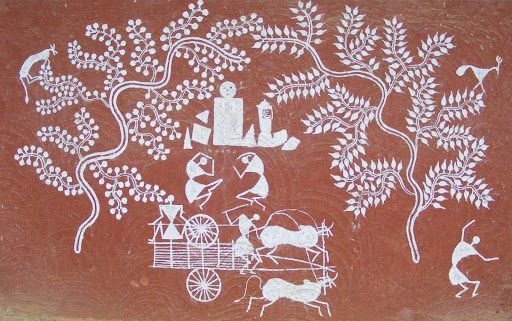Last Updated on February 4, 2023 by Faiza Murtaza
Art and architecture have long been associated with India. In terms of art, India has a long and illustrious history. Almost every state has its own distinct art form. And the art of India’s indigenous groups is the most colourful. Because they had highly distinct rites and qualities, these tribal arts were rich in symbolic themes. Let’s learn more about these indigenous arts and stay close to the roots of our Rich Indian heritage by taking the best online craft classes in order to learn more about these Indian tribal art cultures.
Table of Contents
Here’s a selection of artworks that have symbolised Indian culture and history for decades
1. Warli folk paintings
This Indian tribal art, which is native to Maharashtra, is known for its simple wall paintings. It is considered one of the best examples of folk art. Basic geometrical shapes such as squares, circles, and triangles are employed in this. On a dark red background, these artworks are carved in white colour (bamboo was used as a brush). Hunting, festivals, fishing, farming, dancing, and other everyday scenes are depicted in the picture.
2. Madhubani art
Madhubani is an Indian tribal art genre created by Mithila women. It’s also known as Mithila art, and it’s from Bihar. These Indian tribal art paintings are created on freshly plastered mud walls and feature natural or religious themes. It includes images of Shiva, Krishna, Saraswati, Rama, Durga, the Sun, the Moon, trees, flowers, animals, and wedding scenes, among other things. Brushes, twigs, fingers, matchsticks, and natural dyes and pigments are used to finish the painting. The main goal to learn madhubani painting is to fill in every inch and gap with as many patterns and forms as possible.
3. Saura paintings
The Saura tribe of Odisha is associated with the Saura style of mural painting which is a tribal art of India. These paintings originated in the state of Orissa, although they can also be seen in Maharashtra, Madhya Pradesh, and Jharkhand. They’re also known as Ikons. The painting’s background is made of red or yellow ochre, which is painted with a brush and bamboo. The figures are quite simple and show the simple but meaningful daily life of a local farmer. These paintings resemble Warli paintings in style. The usage of geometrical figures is the only difference between the two. These paintings are created for weddings, births, and other significant occasions.
4. Bhil art
The Bhils are India’s second-largest tribal group. They also provide Bhil art. Madhya Pradesh, Rajasthan, Gujarat, and Maharashtra are the states of origin. This work of Indian tribal art reveals the life of the Bhils themselves. To show life in brilliant colours, one tribe used dots. They attempt to link their art and paintings to their Gods, Goddesses, and the natural world. This comprises carvings of the Sun, Moon, nature, Gods, and other figures on walls or paper using natural and herbal colours. The story behind the picture is simple to comprehend.
5. Tanjore painting or Thanjavur painting
This Indian tribal art, which originated in the Tamil Nadu town of Thanjavur, is a celebration of the region’s rich artistic legacy. This technique was created in the late 16th century. The use of brilliant colours, glass, stones, and gold foils in this historic South-Indian painting style is well-known. They’re created on a hardwood board made of teak or jackfruit. The majority of the artworks portray Hindu Gods and Goddesses. The deities’ visage is designed to have a round face and oval-shaped eyes. After that, the deity’s primary body is encased by an arch, curtain, or other means.
To sum up, it is a source of great pride that Indian tribal art is still practised in many locations and that people have managed to keep them alive after so many years. Every kind of art is constantly evolving. Certain art styles, such as the diverse tribal art seen in India, have, however, withstood the test of time. These kinds of Indian tribal art are still popular in today’s society. Surprisingly, each of these art forms has its own distinct personality. Despite this, they band together in support. Finally, we encourage art lovers who want to try something new to look into Indian tribal art.
Apart from that, if you are interested to know about Commercial Painting Trends then visit our Lifestyle category.






















